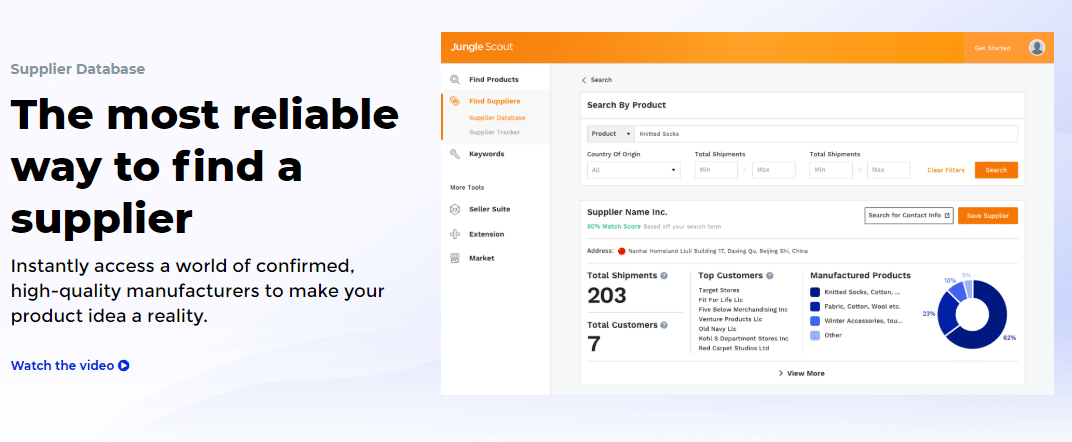Let’s talk about supply chains…
There’s often confusion when this term comes up because depending on the context the term can mean many things.
In this article, we’re covering supply chains as they relate to a small online retail business. We’re not going to cover the big box stores with a complicated logistics system with multiple distributors.
We’re taking a simple approach to a confusing topic so you understand everything involved and launch your online business quicker.
So let’s begin…
What is a Supply Chain?
In simple terms, a supply chain is the system that moves a product from the manufacturer to the customer. An eCommerce business owner is in charge of talking to the manufacturer, arranging transport to a warehouse and then selling the product to the customer.
That entire journey is known as the supply chain. Depending on the size of the operation the supply chain can be larger. Understanding the product supply chain can be the difference between maintaining a healthy profit margin and breaking even.
If at any point in your supply chain there’s a problem the costs are passed on to the retailer and then customers are asked to pay a higher price. You don’t want that. Understanding your supply chain is also how you estimate shipping time for your customers.
The supply chain is every single business that touches your product until it reaches the customer.
- Manufacturer
- Shipping Company/Freight Forwarder
- Warehouse Storage Facility
- Delivery Company
- Final Customer
That’s a simple process for a product that doesn’t require assembly or inspections but it’s very straight forward either way.
The supply chain starts in the factory where the product is being made and doesn’t end until the customer purchases the final product.
Every business has a goal to create the most efficient supply chain to pass the savings onto the customer to make more sales. You can see the most efficient supply chains in action at stores like Walmart and Target.
Supply Chain in Online Retail Businesses
Let’s say you’re starting an online business, it’s important to understand every step of your supply chain. Otherwise you won’t know how to price your products and you won’t be able to grow your business.
A good supply chain involves managing every link in the chain and finding a competitive price every step of the way. So to give you an example we’ll follow a product through each step of the process and see what companies are involved along the way.
Supply Chain Example:
- Manufacturer – Alibaba, Aliexpress, Saleshoo, DHGate
- Inspection Company (Optional) – FBA Inspection
- Freight Forwarder – FedEx, DHL, and UPS
- Warehouse Fulfillment – You, Amazon FBA, Ships-a-lot, FedEx Fulfillment
- Final Customer
- Return Processing – Same Warehouse Fulfillment
(Extra Reading Material – The Best 6 Fulfillment Warehouse Providers)
This is the most basic example of running an online business but for most people that are starting out online this is all that’s necessary. There’s no need to make it more complicated than it needs to be or add more steps than is necessary.
With bigger businesses comes more complexity. For example a store like target doesn’t work directly with manufacturers but they work with distributors who work with wholesalers that work manufacturers because they have too many product lines. The bigger you become, the more difficult it is to work directly with a product source.
How to Find Reliable Suppliers
There are all sorts of scams out there involving sending payments internationally to shady suppliers that never send their products.
That’s what we want to help you avoid by helping you find manufacturers you can trust. Which is why we’ve partnered with JungleScout to bring you a directory of the best suppliers in every type of product category.
We’ve spent so much money dealing with bad suppliers and if you can avoid that yourself then it’s one less headache to deal with.

You can check out the directory here.
If you would rather find a reliable manufacturer on your own we put together a huge guide that details how to find one step by step. Here’s the link to that article.
The more you work with suppliers and freight forwarders the better deals you’re able to negotiate which lead to a more efficient business. It just takes time and a lot of patience to do it.
Wrapping This Up…
The best way to learn about supply chains is by going through the process yourself when you start a business. The first hurdle you have to jump is trying to make a sale.
Once you’re making sales it’s time to start thinking about the profit margins in your product line. That’s when understand the supply chain ecosystem makes sense because you need to optimize every link.
You want every new order you place to become more and more efficient until you have the best margins possible because you know all of your costs like the back of your hand. Take everything one step at a time and it becomes possible to understand this deep business topic.
